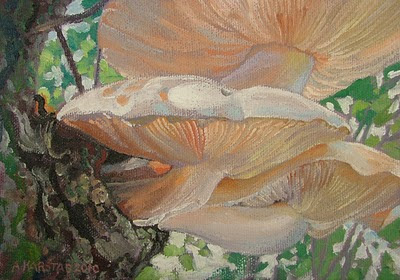Knothole Triplets (oil on canvas 5 x 7 in.) SOLD!
 9 October finds me home again in Bishops Mills, viewing three perfect Elm Knothole Mushrooms growing at head height from a knothole in a tree behind our barn.
9 October finds me home again in Bishops Mills, viewing three perfect Elm Knothole Mushrooms growing at head height from a knothole in a tree behind our barn. These are Hypsizygus ulmarius, the Oyster Mushroom that Fred and I call "Manitoba Maple Knothole Mushroom," though the formal name is "Elm Oyster." Each October we're constantly scanning distant Manitoba Maples for the telltale white spots, often quite high on trunks and branches.
Right now the dehydrator is whirring away in the back porch, drying this year's crop. We slice them and dry them until crisp, then store them in jars in the pantry. Cooked when freshly picked these mushrooms, though very flavourful, are tough and rubbery, but the dried ones cook up nice and tender, and they're a nice snack when eaten dry.
Hypsizygus ulmarius is widely cultivated for food under the Japanese name ‘Shirotamagitake.’ The name 'ulmarius,’ suggests growth on Elms, but the only one we’ve seen on an Elm was on a tree drowned by Beaver-flooding, so they don’t seem to use Elms afflicted by Dutch Elm disease, which is how most of our Elms die.



that is BEE YOU TEE FULL!!
ReplyDeleteLovely picture, Aleta. Interesting that they're edible, too.
ReplyDeleteKay, Alberta